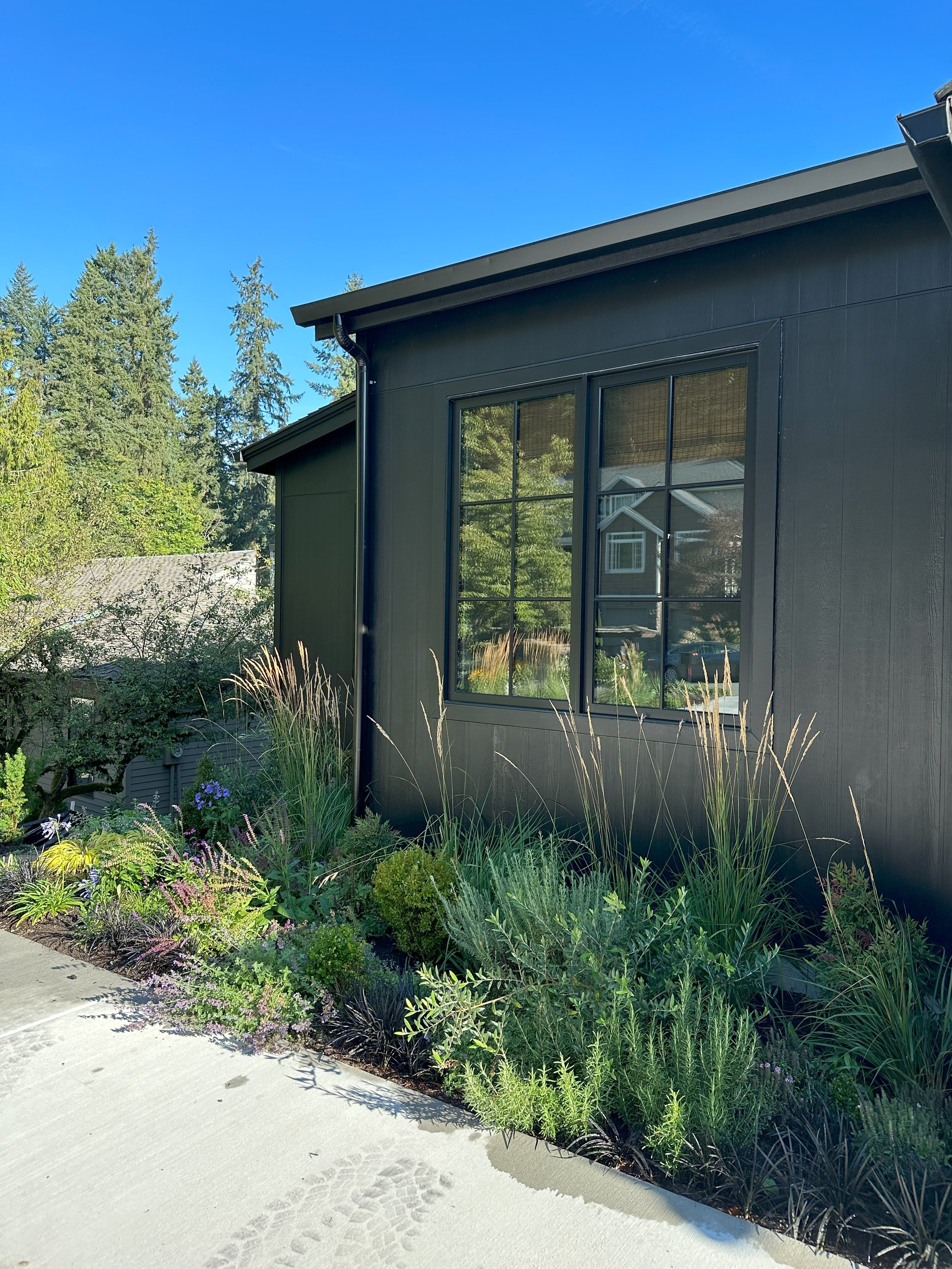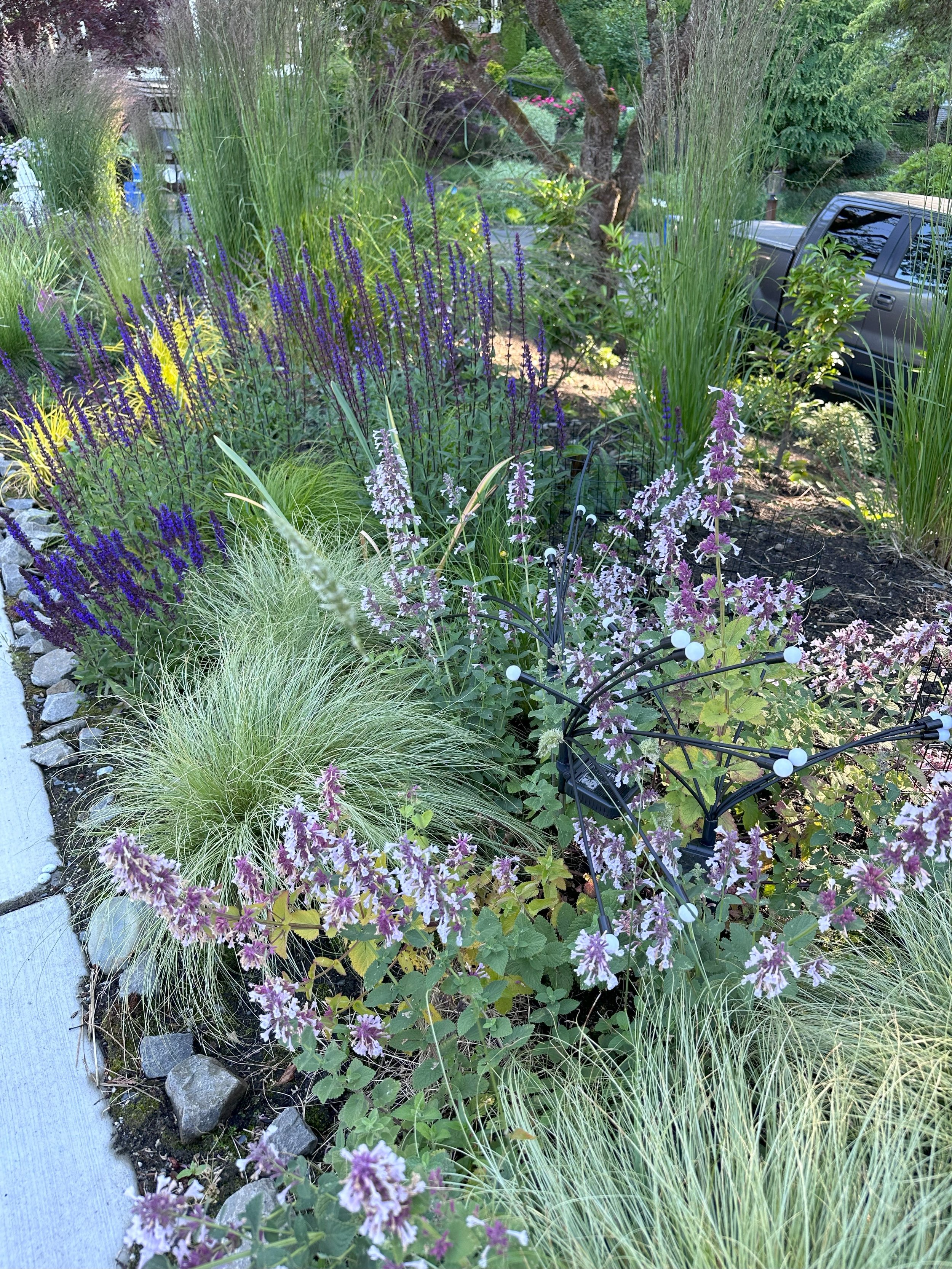Ditch the Lawn: Transform Your Seattle Yard with a Piet Oudolf-Inspired Garden
Mixing structure, texture, color and filler plants evokes emotion and brings me so much joy! The mock up above is the plan for my own home.
Seattle's lush green neighborhoods often come with an ironic twist: the dominance of resource-heavy lawns and shrubs that don’t support our ecosystem or wallet. Lawns require frequent mowing, fertilizing, and watering—not to mention the time and cost involved in keeping them picture-perfect. But what if you could transform your yard into a stunning, sustainable landscape that saves money, attracts wildlife, and requires less maintenance over time?
Typical PNW front yard
AI created image of a totally possible front lawn transformation!
One of my four front garden beds. When we installed it, our landscaper thought I was crazy for planting so many plants very close together and adding no grass to the front. I told him, if he wants to come over every week to mow, edge, over seed and fertilize for free from April-October, be my guest. He laughed at me.
This is the side bed in the front yard during the spring of the first planting season. It was already thriving and covering the soil. The key to low maintenance plantings vs grass is covering the soil to avoid weeds. After a long rainy season, our PNW grass lawns have moss and gaps with dirt. These are perfect places for weed seeds to germinate. This is why our grass is full of weeds and we have to treat it so often with fertilizer and pesticides. There are so many ways to find plants for cheap. I bought most of my grasses on Facebook Marketplace from a school teacher’s side hustle. They were a fraction of the price I would have paid at the nursery. I bought 90 and since then I’ve divided them to fill in my yard and my mom’s.
Here is how it looked during the 2nd growing season during the spring time frame. You can see almost no soil. And at the end of the year - I went out and divided many of these plants to fill up my other garden beds and improve my plant patterns.
Why Lawns and Shrubs Are Outdated
The typical Seattle or Bellevue yard includes a large lawn bordered by hedges or ornamental shrubs. While this classic setup may seem simple, it has several downsides:
High water consumption: Maintaining a lush lawn in the Pacific Northwest requires constant irrigation during our dry summers.
Chemical dependence: Fertilizers and pesticides are often used to keep grass and shrubs looking healthy.
Limited biodiversity: Lawns and tidy shrubs provide minimal support for pollinators, birds, and other beneficial wildlife.
Time-intensive upkeep: Mowing, trimming, and reseeding take up time that could be spent enjoying your garden.
Switching to a naturalistic garden inspired by Piet Oudolf can solve these issues while creating a yard that bursts with color, texture, and life.
The Cost and Savings of a Natural Garden
Above image sources: https://www.dwell.com/article/piet-oudolf-interview-vitra-campus-garden-f08a5223/6825741849459470336
A Piet Oudolf-style garden, rich in perennials, grasses, and seasonal interest, may initially cost more than laying sod or planting traditional shrubs. However, the savings over time are substantial:
Water costs: Natural gardens are drought-tolerant once established, cutting irrigation needs by 50-70%.
Maintenance: Forget weekly mowing or seasonal hedge trimming. Most plants in a natural garden need only an annual trim or division.
Chemicals: Native and adapted plants don’t rely on fertilizers or pesticides, reducing costs and environmental impact.
Time savings: Instead of hours spent maintaining a lawn, you can enjoy your low-maintenance garden.
HOA Benefits: A neighborhood entrance designed with natural landscaping can save HOAs thousands in water and upkeep costs annually.
This is my vision for my own neighborhood entrance. One day I hope to make this happen! It will lift my mood so much driving in. If anyone wants a free naturalistic plant guide for their HOA entrance- with links for ordering and install directions, I will happily provide it for free! email me at hello@shanellerabichev.com. You can also apply for a grant if there is an applicable one available for a public or school location and I will provide free advice, plant and maintenance recommendations: https://agr.wa.gov/departments/business-and-marketing-support/farm-to-school-toolkit/school-gardens-and-farms/grants-and-funding-en
For a typical Seattle or Bellevue lot (about 5,000-7,500 square feet), replacing front and back lawns with a naturalistic garden could save homeowners $1,000-$2,000 annually in maintenance costs. Over 10 years, that adds up to $10,000 or more.
Here is a mock-up of a craftsman home with a large front yard that can be easily transformed in one season.
Plants That Thrive in the Pacific Northwest
Seattle’s mild winters and dry summers are perfect for a diverse range of plants. For a Piet Oudolf-inspired garden, consider the following:
Grasses
Calamagrostis × acutiflora ‘Karl Foerster’ (Feather Reed Grass): A vertical grass for structure.
Muhlenbergia capillaris (Pink Muhly Grass): Adds a soft, cloud-like texture.
Panicum virgatum ‘Shenandoah’ (Switchgrass): Stunning red-tinted foliage in late summer.
Perennials
Echinacea purpurea (Coneflower): Vibrant blooms that attract bees and butterflies.
Rudbeckia fulgida ‘Goldsturm’ (Black-Eyed Susan): Long-lasting yellow flowers.
Salvia nemorosa (Meadow Sage): Pollinator magnet with spikes of purple flowers.
Sedum ‘Autumn Joy’: Succulent foliage and fall seed heads for winter interest.
Bulbs
Allium giganteum: Tall, spherical blooms in early summer.
Tulipa species: Plant in fall for early spring color.
Crocus tommasinianus: Great for naturalizing under grasses.
Where and When to Buy Plants
Local nurseries like Swanson's Nursery and Sky Nursery offer a wide selection of plants perfect for Northwest gardens. Native plant sales hosted by organizations like the Washington Native Plant Society are also excellent sources for eco-friendly options.
Spring: Ideal for planting perennials, grasses, and bulbs.
Fall: The best time to plant shrubs and larger grasses, giving them time to establish roots before summer.
The Process of Transforming Your Yard
Remove the lawn: Sheet mulching or hiring a professional service is the easiest way to get rid of turf.
Plan your design: Group plants with similar water and sun needs together. Focus on layers—grasses for structure, perennials for texture, and bulbs for seasonal pops of color.
Prep the soil: Add compost to improve drainage and fertility.
Plant in stages: Start with foundational plants like grasses and structural perennials, then fill gaps with bulbs and seasonal varieties.
Mulch and water: Mulching reduces weeds and conserves moisture. Water regularly in the first year to help plants establish.
Maintenance Made Easy
Once established, a natural garden is incredibly low-maintenance. Here’s what you’ll need to do:
Winter: Leave seed heads for visual interest and wildlife.
Early spring: Cut back grasses and perennials to make room for new growth.
Divide and conquer: Every 3-5 years, divide plants to maintain their vigor.
Weeding: Mulch and dense plantings minimize weeds, but occasional hand-pulling may be necessary.
The Wildlife Benefits
Switching to a natural garden creates a haven for birds, bees, and butterflies. Nectar-rich plants like Echinacea and Salvia attract pollinators, while seed heads from grasses and perennials provide food for birds in winter. A garden buzzing with life is not only more beautiful but also helps support local ecosystems.
A New Vision for Seattle Yards
Imagine your front yard bursting with grasses swaying in the wind, vibrant flowers in full bloom, and bees happily buzzing. Meanwhile, your backyard becomes a serene retreat where birds visit daily. This transformation is possible for any typical Seattle or Bellevue yard.
With reduced costs, less time spent mowing, and the joy of supporting wildlife, the choice is clear: ditch the lawn and embrace the beauty of a Piet Oudolf-inspired garden.
Transforming your Seattle or Bellevue yard into a Piet Oudolf-inspired naturalistic garden can be both aesthetically pleasing and environmentally beneficial. Below is a curated list of 40 plants and grasses that thrive in the Pacific Northwest, along with their estimated costs and links to online nurseries where they can be purchased.
Perennials
Echinacea purpurea (Purple Coneflower)
Estimated Cost: $8–$12 per plant
Purchase from: Farmer GracyRudbeckia fulgida 'Goldsturm' (Black-Eyed Susan)
Estimated Cost: $7–$10 per plant
Purchase from: Digging Dog NurserySalvia nemorosa 'Caradonna' (Meadow Sage)
Estimated Cost: $9–$13 per plant
Purchase from: Digging Dog NurserySedum 'Autumn Joy' (Stonecrop)
Estimated Cost: $8–$12 per plant
Purchase from: Farmer GracyAster novae-angliae 'Purple Dome' (New England Aster)
Estimated Cost: $7–$11 per plant
Purchase from: Digging Dog NurseryHelenium autumnale (Sneezeweed)
Estimated Cost: $8–$12 per plant
Purchase from: Farmer GracyMonarda didyma 'Jacob Cline' (Bee Balm)
Estimated Cost: $9–$14 per plant
Purchase from: Digging Dog NurseryPhlox paniculata 'David' (Garden Phlox)
Estimated Cost: $8–$12 per plant
Purchase from: Farmer GracyVeronicastrum virginicum 'Fascination' (Culver's Root)
Estimated Cost: $9–$13 per plant
Purchase from: Digging Dog NurseryEryngium planum 'Blue Hobbit' (Sea Holly)
Estimated Cost: $8–$12 per plant
Purchase from: Farmer GracyAchillea millefolium 'Terracotta' (Yarrow)
Estimated Cost: $7–$11 per plant
Purchase from: Digging Dog NurseryNepeta racemosa 'Walker's Low' (Catmint)
Estimated Cost: $8–$12 per plant
Purchase from: Farmer GracyGeranium 'Rozanne' (Cranesbill)
Estimated Cost: $9–$14 per plant
Purchase from: Digging Dog NurseryPersicaria amplexicaulis 'Firetail' (Mountain Fleece)
Estimated Cost: $8–$12 per plant
Purchase from: Farmer GracySanguisorba officinalis (Great Burnet)
Estimated Cost: $9–$13 per plant
Purchase from: Digging Dog NurseryAstrantia major 'Roma' (Masterwort)
Estimated Cost: $10–$15 per plant
Purchase from: Farmer GracyEchinops ritro (Globe Thistle)
Estimated Cost: $8–$12 per plant
Purchase from: Digging Dog NurseryAgastache 'Blue Fortune' (Anise Hyssop)
Estimated Cost: $9–$13 per plant
Purchase from: Farmer GracyCoreopsis verticillata 'Moonbeam' (Tickseed)
Estimated Cost: $7–$11 per plant
Purchase from: Digging Dog NurseryLiatris spicata (Blazing Star)
Estimated Cost: $8–$12 per plant
Purchase from: Farmer Gracy
Grasses
Calamagrostis × acutiflora 'Karl Foerster' (Feather Reed Grass)
Estimated Cost: $10–$15 per plant
Purchase from: Hoffman NurseryPanicum virgatum 'Shenandoah' (Switchgrass)
Estimated Cost: $12–$18 per plant
Purchase from: Hoffman NurseryMiscanthus sinensis 'Morning Light' (Maiden Grass)
Estimated Cost: $10–$15 per plant
Purchase from: Hoffman Nursery
Contact Us for Seattle Garden Design Services
Ready to transform your yard in Seattle, Bellevue, Bothell, Woodinville, or Kirkland? At Shanelle Rabichev Garden Design, we specialize in creating lush, sustainable landscapes inspired by Piet Oudolf. Let’s bring your dream garden to life! contact hello@shanellrabichev.com
Note: I edit my writing/grammar for blog posts via AI, but mix with my ‘raw’ writing because it ‘feels’ more natural. Apologies for any grammar or spelling errors in those sections. AI editing suggestions are always better than what I originally write, but I prefer to keep my own voice/personality in the writing. Please send thoughts and feedback to hello@shanellerabichev.com or leave a comment.
















